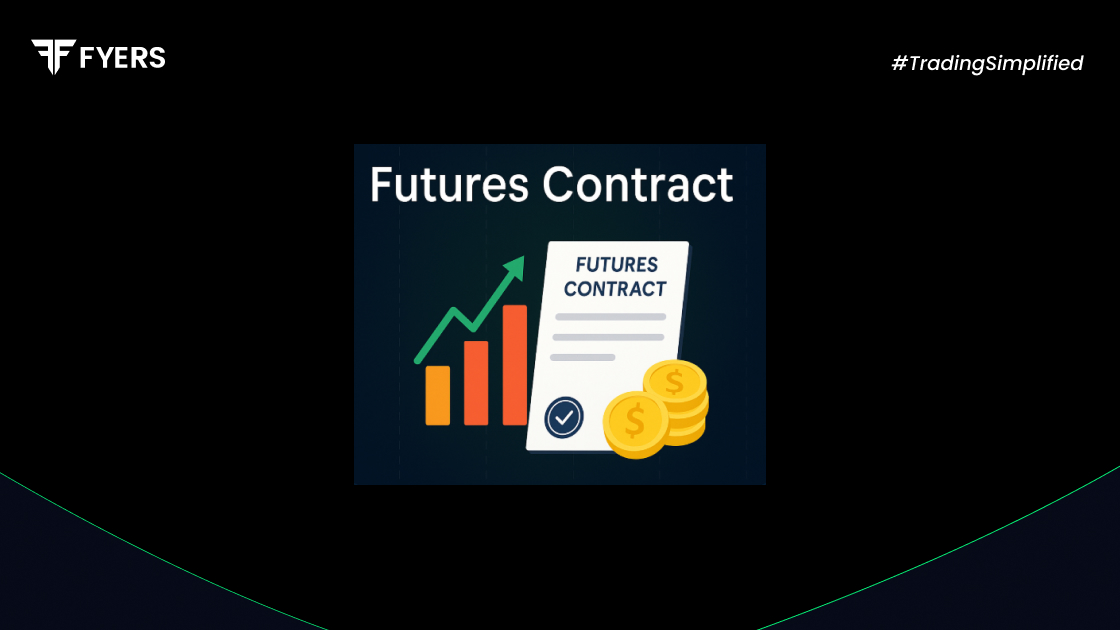

 30 Sep, 2025
30 Sep, 2025
 5 mins read
5 mins read

Futures contracts play a crucial role in the world of financial markets, especially in hedging risk and speculating on price movements. Whether you're new to trading or looking to deepen your understanding, learning how futures contracts work can help you make more informed decisions. This guide explains what they are, how they work, and their key features - along with real-world examples.
A futures contract is a legal agreement to buy or sell an asset at a predetermined price on a specific future date. These contracts are standardised and traded on recognised exchanges such as the NSE or BSE.
The asset in question could be anything - commodities like crude oil and wheat, financial instruments like stock indices, or even currencies. Unlike spot contracts, which require immediate settlement, futures contracts defer the transaction to a future date.
When two parties enter a futures contract, they agree on the quantity, price, and date of delivery or settlement. Each contract has a specific expiration date. Traders can either:
Hold until expiry and settle it through physical delivery or cash.
Square off before expiry by entering into an opposite position.
For example, if you agree to buy 100 barrels of crude oil at ₹6,500 per barrel for delivery in December, you can either take delivery or close the position by selling an identical contract before expiry.
Futures are marked-to-market daily, meaning gains and losses are settled at the end of each trading day, ensuring transparency and risk control.
Futures contracts have several defining characteristics:
Standardisation: The contract size, expiration date, and tick size are pre-defined by the exchange.
Leverage: Traders can take large positions with a small margin deposit.
Liquidity: Futures are highly liquid, especially for popular indices and commodities.
Margin Requirement: A minimum margin (initial and maintenance) must be maintained in the trading account.
Mark-to-Market (MTM): Daily settlement of profits and losses.
Expiry Date: All contracts have a fixed expiry, usually monthly or quarterly.
Settlement Options: Depending on the contract, settlement can be physical (goods delivery) or cash-based.
Let’s say you expect the Nifty 50 index to rise in the next month. It’s currently at 19,000 points. You enter a futures contract to buy one lot of Nifty futures (say, size = 50 units) at ₹19,100.
At expiry, the Nifty closes at 19,500. Your profit:
= (19,500 – 19,100) × 50
= ₹400 × 50 = ₹20,000
If the index had closed below 19,100, you would incur a loss instead.
Futures contracts offer multiple benefits to traders and investors:
Hedging Tool: Ideal for reducing price risk in volatile markets (e.g., farmers, exporters).
Speculative Gains: Traders can profit from both rising and falling markets.
High Liquidity: Popular contracts like Nifty, Bank Nifty, and Gold futures are extremely liquid.
Cost Efficiency: Lower brokerage and transaction costs compared to other derivatives.
Transparency: Traded on regulated exchanges with real-time price updates and position monitoring.
Despite their benefits, futures contracts come with some drawbacks:
Leverage Risk: While leverage can magnify profits, it also increases potential losses.
Expiry Risk: If a position is not squared off before expiry, it can result in forced delivery or cash settlement.
Margin Calls: Daily mark-to-market adjustments can lead to margin calls if the account falls below the maintenance level.
Complexity: Understanding contract specifications, settlement rules, and margining can be overwhelming for beginners.
Every financial instrument carries risk, and futures contracts are no exception:
Market Risk: Adverse price movements can result in significant losses.
Liquidity Risk: Not all contracts are equally liquid, which could affect entry and exit.
Volatility: High intraday price swings may lead to premature stop-outs.
Counterparty Risk: Though mitigated by the exchange, extreme scenarios (like default) may still pose a threat.
Overtrading: Leverage can tempt traders to take larger positions than they can handle, leading to emotional decision-making.
Risk management tools like stop-loss orders, proper position sizing, and maintaining sufficient margin balances are critical for trading futures responsibly.
Futures contracts are powerful tools for hedging and speculative trading. They offer flexibility, transparency, and high liquidity, but they also come with substantial risk due to leverage and volatility. Understanding how they work, their features, and associated risks is essential before stepping into futures trading. Whether you're looking to manage exposure or take advantage of short-term market moves, futures contracts can be a valuable part of your financial strategy - if used wisely.
Profit or loss in a futures contract is calculated as the difference between the entry and exit prices, multiplied by the lot size. For example, if you buy a futures contract at ₹1,000 and sell it at ₹1,050, with a lot size of 100, your profit is ₹5,000. Similarly, a fall in price would result in a loss.
Futures are traded by a range of participants—hedgers such as farmers and corporates who want to reduce price risk, speculators who aim to profit from market movements, and arbitrageurs who exploit price differences. Institutional investors and retail traders also actively participate in the futures market.
No, not all futures contracts end in physical delivery. Most are cash-settled, especially in the equity and index segment. Traders usually square off their positions before expiry to avoid actual delivery. However, in commodities, physical delivery is possible if contracts are held until expiry.
Calculate your Net P&L after deducting all the charges like Tax, Brokerage, etc.
Find your required margin.
Calculate the average price you paid for a stock and determine your total cost.
Estimate your investment growth. Calculate potential returns on one-time investments.
Forecast your investment returns. Understand potential growth with regular contributions.